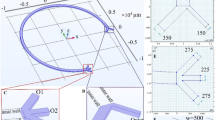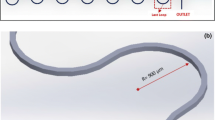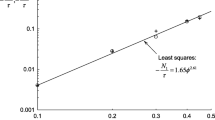Abstract
A model is developed, allowing estimation of the share of inelastic interparticle collisions in total energy dissipation for stirred suspensions. The model is restricted to equal-sized, rigid, spherical particles of the same density as the surrounding Newtonian fluid. A number of simplifying assumptions had to be made in developing the model. According to the developed model, the share of collisions in energy dissipation is small.
Similar content being viewed by others
Abbreviations
- b :
-
parameter in velocity distribution function (Eq. (28))
- c K :
-
factor in Kolmogoroff spectrum law (Eq. (20))
- D t(r p ) m2/s:
-
characteristic dispersivity at particle radius scale (Eq. (13))
- E(k, t) m3/s2 :
-
energy spectrum as function of k and t (Eq. (16))
- E K (k) m3/s2 :
-
energy spectrum as function of k in Kolmogoroff-region (Eq. (20))
- E p :
-
dimensionless mean kinetic energy of a colliding particle (Eq. (36))
- E cp :
-
dimensionless kinetic energy exchange in a collision (Eq. (37))
- G(x, s) :
-
dimensionless energy spectrum as function of x and s (Eq. (16))
- G B(x):
-
dimensionless energy spectrum as function of x for boundary region (Eq. (29))
- G K(x):
-
dimensionless energy spectrum as function of x for “Kolmogoroff”-region (Eq. (21))
- g m/s2 :
-
gravitational acceleration
- I cp :
-
dimensionless collision intensity per particle (Eq. (38))
- I cv :
-
dimensionless volumetric collision intensity (Eq. (39))
- k l/m:
-
reciprocal of length scale of velocity fluctuations (Eq. (17))
- K :
-
dimensionless viscosity (Eq. (13))
- n(2):
-
dimensionless particle collision rate (Eq. (12))
- n′(r) l/s:
-
particle exchange rate as function of distance from observatory particle center (Eq. (7))
- r m:
-
vector describing position relative to observatory particle center (Eq. (2))
- r m:
-
scalar distance to observatory particle center (Eq. (3))
- r pm:
-
particle radius (Eq. (1))
- s :
-
dimensionless time (Eq. (10))
- SC kg/ms3 :
-
Severity of collision (Eq. (1))
- t s:
-
time (Eq. (2))
- u(r, t) m/s:
-
velocity vector as function of position vector and time (Eq. (2))
- u(r, t) m/s:
-
magnitude of velocity vector as function of position vector and time (Eq. (3))
- u r(r, t) m/s:
-
radial component of velocity vector as function of position vector and time (Eq. (3))
- u r (r, t) m/s:
-
magnitude of radial component of velocity vector as function of position vector and time (Eq. (3))
- u ϕ (r, t) m/s:
-
latitudinal component of velocity vector as function of position vector and time (Eq. (3))
- u ϕ (r, t) m/s:
-
magnitude of latitudinal component of velocity vector as function of position vector and time (Eq. (3))
- u ψ (r, t) m/s:
-
longitudinal component of velocity vector as function of position vector and time (Eq. (3))
- u ψ (r, t) m/s:
-
magnitude of longitudinal component of velocity vector as function of position vector and time (Eq. (3))
- u gsm/s:
-
superficial gas velocity
- u′(r) m/s:
-
root mean square velocity as function of distance from observatory particle center (Eq. (3))
- u′r(r) m/s:
-
root mean square radial velocity component as function of distance from observatory particle center (Eq. (4))
- u′ϕ (r) m/s:
-
root mean square latitudinal velocity component as function of distance from observatory particle center (Eq. (4))
- u′ψ (r) m/s:
-
Root mean square longitudinal velocity component as function of distance from observatory particle center (Eq. (4))
- w′(x) :
-
dimensionless root mean square velocity as function of dimensionless distance from observatory particle center (Eq. (11))
- V pm3 :
-
particle volume (Eq. (36))
- w′(2):
-
dimensionless root mean square collision velocity (Eq. (34))
- w * :
-
parameter in boundary layer velocity equation (Eq. (24))
- x :
-
dimensionless distance to particle center (Eq. (9))
- x * :
-
value of x where G Band G K-curves touch (Eq. (32))
- x K :
-
dimensionless micro-scale (Kolmogoroff-scale) of turbulence (Eq. (15))
- α :
-
volumetric particle hold-up
- ε m2/s3 :
-
energy dissipation per unit of mass
- ν m2/s:
-
kinematic viscosity
- ρ kg/m3 :
-
density
- Φ(r) m3/s:
-
fluid-exchange rate as function of distance to observatory particle center
- φ :
-
Latitudinal co-ordinate (Eq. (5))
- ψ :
-
Longitudinal co-ordinate (Eq. (5))
References
Cherry, R. S.; Papoutsakis, E. T.: Hydrodynamic effects on cells in agitated tissue culture reactors. Bioprocess. Eng. 1 (1986) 29–41
Beverloo, W. A.: Characteristic distances in suspensions of equally sized spherical particles (in preparation)
Hinze, J. O.: Turbulence (second edition) New York: McGraw-Hill 1975
Hinze, J.O.: Turbulent fluid and particle interaction. Prog. Heat Mass Transfer 6 (1971) 433–452
Bradshaw, P. (Ed.): Turbulence. Topics in applied physics, vol. 12. Berlin: Springer 1976
Tennekes, H.; Lumley, J. L.: A first course in turbulence, Cambridge: MIT Press 1972
Pao, Y.-H.: Structure of turbulent velocity and scalar fields at large wavenumbers. Phys. Fluids 8 (1965) 1063–1075
Cherry, R. S.; Papoutsakis, E. T.: Understanding and controlling injury of animal cells in Bioreactors. In: Spier, R. E.; Griffiths, J. B. (Eds.): Animal cell biotechnology. vol. 4. New York: Academic Press 1990
De Gooijer, C. D.; Wijffels, R. H.; Tramper, J.: Growth and substrate consumption of Nitrobacter agilis cells immobilized in carrageenan: Part 1, Dynamic modelling. Biotechnol. Bioeng. 38 (1991) 224–231
Author information
Authors and Affiliations
Rights and permissions
About this article
Cite this article
Beverloo, W.A., Tramper, J. Intensity of microcarrier collisions in turbulent flow. Bioprocess Engineering 11, 177–184 (1994). https://doi.org/10.1007/BF00369627
Received:
Issue Date:
DOI: https://doi.org/10.1007/BF00369627




